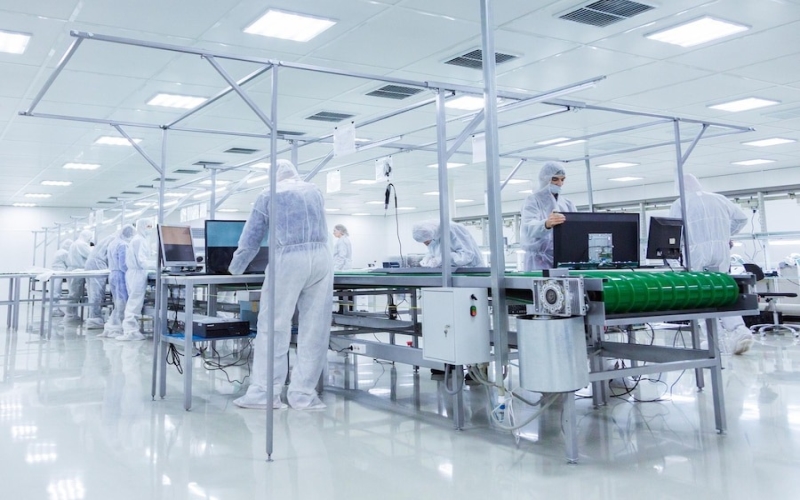Cleanrooms play an integral part in regulating contamination levels, humidity, pressure, and temperature across various industries. They are specially designed environments with controlled levels of pollutants such as aerosol particles, dust, and vapors.
Cleanrooms are used in various industries, including pharmaceuticals, biotechnology, and healthcare, where even the smallest contaminants can pollute the results or quality of the entire production line.
Let’s discuss the features of cleanrooms and their importance.
Key Attributes of Cleanrooms
Controlled Air Quality
Cleanrooms have strict control over air quality. Regular vacuuming procedures, even if the organization uses HEPA filters, are not allowed for cleanrooms. This is because these processes would not be 100% efficient.
This is why cleanroom standards are so strict. Any mistake or accidental contamination of the most minuscule of air particles can cause the cleanroom production line to become contaminated and unsafe.
Most technologically advanced cleanrooms are able to keep airborne contaminants and similar risks at bay because of the improved indoor air quality offered by industrial humidification systems.
This involves filtering the air to remove particles and controlling temperature, humidity, and airflow to minimize the presence of contaminants.
As per American Cleanroom Systems, cleanrooms mostly use ULPA or HEPA filtration systems for air purification and create an ultra-clean environment. With systematic air purification, it is possible to reduce the count of particles from greater than 500k/ft to as low as 100/ft.
Cleanroom Classifications
Cleanrooms are classified based on the size and number of particles permitted per unit of air. The International Organization for Standardization (ISO) has a series of standards specifically for clean rooms. These standards outline the practices and procedures that companies are required to follow to avoid the risk of contamination.
The classification is usually defined by international standards, such as ISO 14644 or the Federal Standard 209E. The higher the classification, the cleaner the room.
Specialized Clothing
People entering cleanrooms wear special clothing such as cleanroom suits, gloves, and sometimes even masks and hair covers. This prevents human-generated contaminants from entering the cleanroom environment.
In this regard, using protective clothing that adheres to the Hazard analysis and critical control points (HACCP) is crucial when it comes to eliminating safety issues. It is a systematic preventive approach to safety from chemical, biological and physical hazardous particles in sterilized production processes.
Equipment and Furnishings
All equipment and furnishings in a cleanroom are designed to reduce particle generation to a minimum. Materials used in cleanrooms are often selected for their low particle emission characteristics.
The furniture in the cleanroom should generate minimal air contamination. Using antistatic materials is highly important, especially if the cleanroom facility will be used for the production of electronic components. The surfaces of seating furniture should be highly resistant to wear and tear and should never be made of fabrics.
Stringent Protocols
Cleanrooms operate under strict protocols and procedures to maintain cleanliness. Periodic monitoring and testing are conducted to ensure that the cleanliness levels are within specified limits.
In order to certify a cleanroom to a chosen class of ISO 14644-1, cleanroom validation by third-party validation agencies is necessary. Each class has its unique safety and hygiene protocols that the facility must follow as per the specified classification that it has been validated for.
There are a number of reasons for which cleanroom validation is performed:
- To make sure that the design of the production facility is ideal based on its intended purpose
- To ensure that the equipment and environment of the facility meets User Requirement Specifications (URS)
- To make sure that the cleanroom facility meets the regulatory requirements and the defined ISO standards.
Applications of Cleanrooms Across Industries
Cleanrooms play a crucial role in maintaining high-quality standards in various industries, ensuring that products are free from contaminants and meet stringent specifications. Some of those industries include:
- Pharmaceuticals and Biotechnology: Cleanrooms are used in the manufacturing of drugs, vaccines, and other biotechnological products.
- Semiconductor Manufacturing: In the production of microchips and other electronic components where even tiny particles can lead to defects.
- Aerospace: The aerospace industry uses cleanrooms for the assembly and testing of sensitive components, satellite systems, and spacecraft.
- Biomedical Research and Laboratories: Cleanrooms are used in research settings, particularly in fields like microbiology and genetics, where the control of contaminants is crucial.
- Food and Beverage Processing: Certain segments of the food and beverage industry, especially in the production of highly sensitive or sterile products, may use cleanroom facilities.
- Healthcare: In certain medical procedures, particularly those involving the manufacturing of drugs, sterile medical devices, and pharmaceuticals.
Wrapping Up
Cleanrooms are available in all sorts of sizes: from large facilities catering to installation parts of automobiles to an area of a few hundred square meters for food processing units. Each sector uses a cleanroom in its own way. But, to prevent products or an entire production line from getting contaminated, it is important to adhere to the universal standards of cleanroom maintenance, irrespective of the industry.





